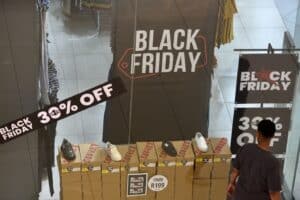There is no more money, as Moneyweb managing editor Ryk van Niekerk succinctly summed it up after Wednesday’s Medium-Term Budget Policy Statement. There is not really any good news either (the ‘best’ news in Treasury’s 86-page document is that the decade-overdue mobile spectrum auction will finally happen, but only because the fiscus needs the revenue). Worse, there’s zero evidence that the situation is going to get any better.
Look around you. The cranes in Sandton are slowly reducing in number, as mega head office projects signed off five or more years ago are completed. House prices have gone backwards (after inflation) since the 2007/2008 peak, and the market has been almost exactly flat for three-plus years. Consumer spending is stuttering along. Panicked emigration sales flood neighbourhood groups on Facebook, but even those are starting to slow. Those who have had the means to leave, have left.
And there’s nothing obvious that is going to change this picture. Economic growth has ‘decoupled’ from the rest of the world, both developed and emerging markets alike. Finance minister Malusi Gigaba could only vaguely refer to a global environment that “may be helpful, as growth is improving, despite persisting risks”
Fracking in the Karoo, once heralded as the catalyst of all catalysts to kick-start growth and job creation, is all but dead. With all the dithering, we missed that boat too. Penny for the thoughts of some of the economic cluster ministers. Government’s (once?) world-leading renewable energy programme stumbles forward, from one hostage-taking acting Eskom CEO and energy minister to the next.
Where does the growth come from? (Hint: nowhere)
Add to this the toxic stew of almost guaranteed further cuts to our credit rating, rising borrowing costs and a mountain of sovereign debt (already R2.53 trillion, and climbing) and the picture deteriorates quickly. Debt-service costs will be R223.4 billion or 15% of revenue by 2020/21, a number that seems awfully low given the ‘straight-lining’ of the increase to around R20 billion a year in each of the next three years. I would bet my shirt on these numbers being dead wrong.
What confidence local and international investors (providers of capital) as well as the ratings agencies have in this medium-term budget framework remains to be seen. Pragmatic efforts at ‘fiscal consolidation’, which ratings agencies had mostly believed until musical chairs in the finance ministry, is out the window. Government debt-to-GDP will reach eye-watering levels of over 60% within the next five years. And that’s probably a best-case scenario if things continue the way they have been.
“But, that’s fine… look at any number of other countries around the world where debt-to-GDP is a lot higher,” some of the Twitterati cried on Wednesday afternoon. Sure, but those countries are growing… We’re not.
It is not clear how we get back to above 1% growth in the medium term, never mind 2% as the downwardly-revised, but still fairytale, forecasts yesterday suggest.
Deferring the “tough” calls – many of which have to be made in February – to yet another committee suggests that Gigaba doesn’t have the confidence – or political capital – or technical expertise – to make them himself. Most of this is not of Gigaba’s making, mind you.
The ‘involvement’ of the International Monetary Fund is already being floated/tested as a possibility by those in Treasury.
Beware of bankers bearing bailouts.
I cautioned in July this year that things were (very) bad out there. And, I suggested that one ought to prepare for the worst. Right now, sirens should be ringing loudly in your head. Be prepared, no matter how insulated you think you’ll be.
Most readers of this, however, will be fine. Those two million ‘affluent’ shoppers that every supermarket group is chasing – aggressively – will be fine. Sure, they’ll skimp on this and that and cut back on the overseas travel, but they’ll be ok (what the retailers won’t say is that this is the only part of the market that’s actually spending).
The upmarket restaurants in the northern suburbs – mostly “tapas-style” these days because it increases spend per head – will still be overflowing on weekends. A Breitling boutique and designer Paul Smith shop are opening in Sandton City soon. What must surely be one of the largest Michael Kors stores in the world is about to start trading at Mall of Africa. The sprawling Prada boutique in Sandton City’s ‘Diamond Walk’ will trade as if nothing’s happened. WineX will be full, like it was last night. Walking around the Sandton Convention Centre seemed a completely different universe to the one described by the minister earlier in the afternoon.
The real pain will be felt in the (firmly) middle and lower-middle class. Take a drive through parts of the West and East Rand and you’ll see exactly what I mean. There is ample evidence in the results of JSE-listed companies trading in that segment of the market that proves the point over and over and over. Small town (and city) South Africa will continue to face the inescapable onslaught of emigration (to the metros), soaring unemployment and (mostly) negative growth.
But… everything will be fine. Until it isn’t.







